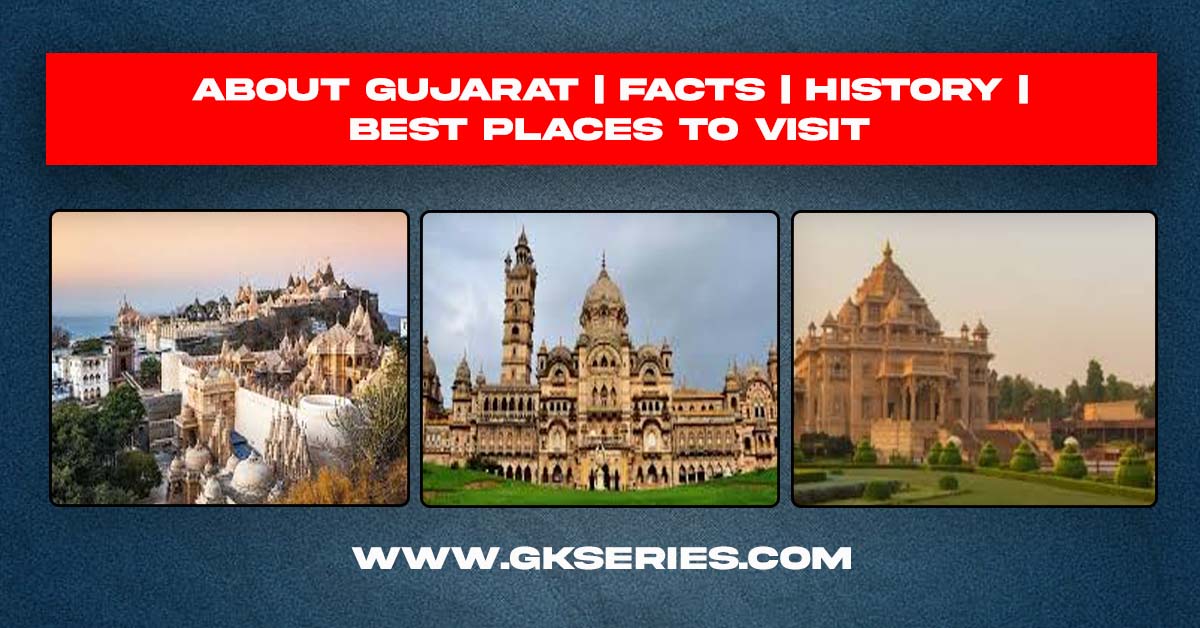
In this article, we provide comprehensive information about the geography, history, population, and top tourist destinations of Gujarat. Gujarat, located in western India, is a lively mix of culture, history, and natural beauty. Cities like Ahmedabad blend ancient heritage with modern development, featuring landmarks like the Sabarmati Ashram and the beautifully carved Adalaj Stepwell. The state is renowned for its delicious cuisine, including dhokla, thepla, and sweet treats like ghari. Festivals such as Navratri fill the region with vibrant garba dances and lively celebrations.
| About: | Gujarat is a state located on the western coast of India, boasting a coastline of approximately 1,600 km (990 mi), which is the longest in the country, primarily situated on the Kathiawar peninsula. It ranks as the fifth-largest state in India by area, covering around 196,024 km² (75,685 sq mi), and is the ninth-most populous state, with a population of 60.4 million as of 2011. The state shares its borders with Rajasthan to the northeast, Dadra and Nagar Haveli and Daman and Diu to the south, Maharashtra to the southeast, Madhya Pradesh to the east, and the Arabian Sea and the Pakistani province of Sindh to the west. Gandhinagar serves as the capital city, while Ahmedabad is the largest city. The indigenous people of Gujarat are known as Gujaratis, and their official language is Gujarati. The state is home to 23 sites from the ancient Indus Valley civilization, more than any other state in India. Notable sites include Lothal, recognized as the world’s first dry dock, Dholavira, the fifth largest site, and Gola Dhoro, where five rare seals were discovered. Lothal is thought to have been one of the earliest seaports in the world. Gujarat’s coastal cities, particularly Bharuch and Khambhat, functioned as important ports and trading hubs during the Maurya and Gupta empires, as well as during the reign of the royal Saka dynasties in the Western Satraps era. Alongside Bihar, Mizoram, and Nagaland, Gujarat is one of four Indian states that prohibit the sale of alcohol. Additionally, the Gir Forest National Park in Gujarat is the only place in the world where the Asiatic lion can be found in the wild. |
| History: | The State took it’s name from the Gujjars, who ruled the area during the 700’s and 800’s. Stone Age settlements around Sabarmati and Mahi rivers indicate the same time as that of the Indus Valley Civilization while Harappan centres are also found at Lothal, Rampur, Amri and other places. Rock Inscriptions in the Girnar Hills show that the Maurya Emperor Ashoka, extended his domain into Gujarat in about 250 BC. With it’s fall, the control of the region came under the Sakas or Scythians. During the 900’s the Solanki Dynasty came to power and Gujarat reached it’s greatest extent. Then followed a long period of Muslim rule. Ahmed I, the first independent Muslim ruler of Gujarat, found Ahmedabad in 1411. The Mughal Emperor Akbar conquered Malwa and Gujarat in 1570s. The British East India Company set its first footsteps in Surat in 1818 and the State came in control of their rule. Gujarat was divided into princely states. After the Indian Independence in 1947, all of Gujarat except Saurashtra and Kutchh became part of Bombay State until May 1, 1960, when the Government split Bombay state into the States of Maharashtra and Gujarat. Ahmedabad became the chief city of the new State and housed the State Government Offices. They remained there until they were transferred to Gandhinagar in 1970. |
| Economy: | Gujarat’s economy is the fourth-largest in India, boasting a gross state domestic product (GSDP) of ₹16.55 trillion (approximately ₹19 trillion or US$220 billion in 2023). It also has the 10th-highest GSDP per capita in the country, standing at ₹215,000 (US$2,600). The state leads in exports, contributing to about one-third of the national total. While it ranks 21st among Indian states and union territories in terms of the human development index, Gujarat is recognized as one of the most industrialized states with a low unemployment rate. However, it does face challenges in certain social indicators and has experienced instances of religious violence. |
| Region: | West India |
| Capital: | Gandhinagar |
| Country : | India |
| Language: | Gujarati, Hindi |
| GPD: | ₹27.90 trillion |
| Largest city: | Ahmedabad |
| Population: | 60,439,692 (2011) |
| Major Attractions to Visit: | 1. Statue Of Unity 2. Junagadh 3. Ahmedabad 4. Baroda 5. Sasan Gir National Park 6. Nahargarh Archeological Park 7. Rani Ka Vav 8. Dwarkadhish Temple 9. Somnath 10. Bhuj |





